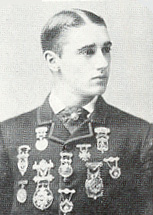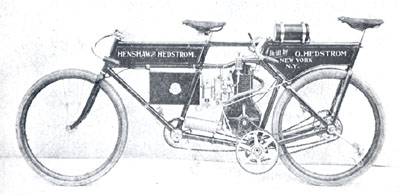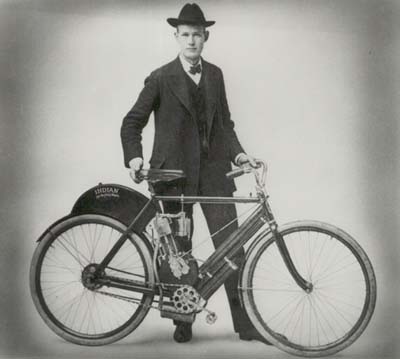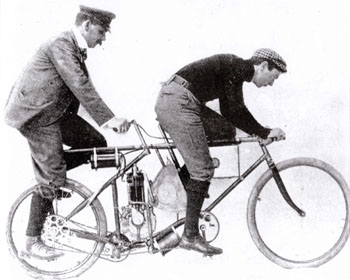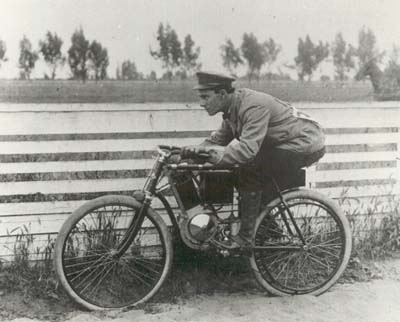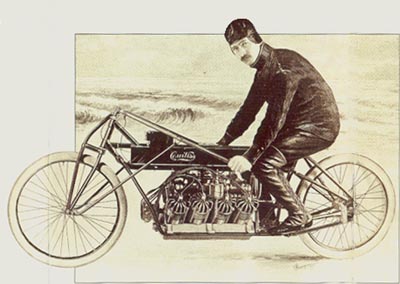In case you don't know what you are riding...
Here is a definition of different types of scooters and a glossary of common 'scoot culture' terms.
What is a scooter?
The term "scooter" as commonly used in the newsgroup (NG) alt.scooter refers more properly to a "motorscooter", which are a subclass of motorcycles utilizing a distinctive structural design. These are generally two-wheeled vehicles originally based on motorized versions of children's push scooters, although some three-wheeled scooters are considered to exist. Motorscooters (or simply "scooters") have been around almost as long as motorcycles and the distinction between the two has often been blurred. The most commonly accepted definition of scooters requires two-wheeled vehicles (or two-wheeled vehicles modified to have a rear axle) that have wheels between 8 and 14 inches in diameter (smaller than motorcycles), step-thru frames and typically engines that are low and close to the rear wheel [see The New Encyclopedia Britannica (1997), vol. 8, pg. 367]. However, it should be noted that this definition is not universally accepted, as some have argued (Dregni & Dregni, for example) that scooters need only have 2 out of 3 of these attributes. Scooters also often incorporate full bodywork, including legshields and generally are designed to be easier to operate than standard motorcycles. It should be noted that scooters may be of any engine size, though historically they typically have ranged from 50cc to 250cc. Likewise, there is no limitation to possible top speed inherent in scooter design -- many scooters regularly exceed 100mph. Incidentally, the term "scooter" is also commonly used for "medical scooters", which are typically 3 or 4 wheeled vehicles for people with mobility problems, but are quite unlike "motorscooters". There are also scooters with very small engines (under 40cc) commonly called "go-peds" (a prominent brand), which look like motorized children's push scooters. However, they are not covered by this FAQ because they have their own NG, alt.sport.go-ped and since they differ significantly from the larger motorscooters commonly discussed on the "alt.scooter" NG. There is also a popular German techno band named "Scooter" that sometimes leads to confusion as well, especially when using search engines. [11/99]
How do scooters differ from mopeds?
It is a common mistake for people to confuse scooters and mopeds. In fact, many vehicles are BOTH. By legal definition, a "moped" is any two-wheeled vehicle of any design which meets local regulations that commonly relate to speed restriction. Commonly, mopeds may not exceed 30-35mph and still legally be considered mopeds. Confusion reigns, however, because some localities may require pedals, while others do not, and speed restrictions may vary from place to place. Further, a common moped design has been large, motorcycle-type wheels on vehicles that can commonly look very much like scooters, blurring the distinction. However, the term "moped" in any locality will always refer first to any vehicle that meets local regulations to such vehicles, and secondly to whatever designs people there may commonly associate with mopeds. Many speed-restricted scooters are legally marketed as mopeds, sometimes even with pedals (in places that require them). The overlap simply goes to body design with speed restrictions. It should be noted that most mopeds can be modified to exceed designed speed, in which case they are no longer legally mopeds, but motorcycles. If they have a scooter design, they will simply be faster scooters.
How do scooters differ from motorcycles?
By definition, motorcycles are nearly any two-wheeled, motorized vehicle. Therefore, scooters are by definition simply a specific motorcycle design. This is why in most localities, there are no regulations for scooters per se, and thus scooters fall either under moped regulations (assuming they meet the proper requirements to do so) or by default, they are legally treated as motorcycles. There are a few localities that have specific regulations for scooters, but as these are extremely uncommon and follow no real pattern, they are not covered here. The reason that scooters are commonly not treated as equals in motorcycle circles is simply because they generally are slower and not as performance-oriented as their larger cousins. So technically, all scooters are motorcycles, though usually only scooters that more closely resemble what are more commonly called motorcycles will be referred to as such.
What are "classic" scooters?
The term "classic" scooter has been coined to differentiate the older, original scooter designs from those that developed later on in the 80s and 90s. Piaggio has produced its Vespa scooters since 1946 and the design has been endlessly copied by other makers right up to the present day. Likewise, other makers have copied Lambretta designs. There have also been a few innovative designs related to neither, but the vast majority of "classic" scooters are variations of a Vespa or Lambretta. Those that prefer this type will commonly point to the classic 50s and 60s styling, almost exclusive use of metal bodywork, extensive use of manual shifting mechanisms, kickstarters, and typically older scooters, though these designs are still produced all over the world. Contrary to popular belief, even early Japanese scooter design followed the "classic" scheme, which is why 50s and 60s Japanese scooters by Fuji, Mitsubishi, Honda and Yamaha are all commonly accepted in classic scootering circles. Likewise, some "classic" scooters have automatic transmissions (e.g. Fuji Rabbit, Heinkel Tourist) and electric starters (e.g. some Vespa and Lambretta models).
What are "modern" scooters?
Vespa and Lambretta scooters long dominated world markets and all those attempting to compete typically copied their designs. This included early scooters produced in Japan. Because those designs ultimately could not compete with Vespa and Lambretta, scooters were no longer produced in Japan in the 70s. When the 80s dawned, Honda and Yamaha decided it was time again for them to produce scooters, albeit with a different design concept. These new designs featured radical, futuristic styling; plastic body panels to reduce costs; automatic shifting and many features not commonly found on older Vespa and Lambretta scooters. These are now called "modern" scooters to differentiate them from the older, "classic" designs. It should be noted that Piaggio produces both the "classic" Vespa scooter line and a wildly popular "modern" scooter line as well. Because "classic" scooters are still produced by several companies, the terms do not relate to date of manufacture. It is typical of "modern" scooter design that the distinction between motorcycles and scooters has been seriously blurred, though it still clearly remains.
What are "retro" scooters?
Because the classic Vespa and Lambretta designs have endured in popularity for so very long and continue to sell well even today, there have been recent attempts to market essentially modern scooters with classically styled frames. A recent well-known attempt would be Italjet with their Velocifero that has been widely marketed all over the world, including the USA. Because the Velocifero uses a metal body in a classic design, some also consider it a classic scooter, though others aren't so sure. When Honda went to market it's Giorno, with a plastic body, it was seen as naked attempt to copy the Vespa magic. Likewise, Yamaha has produced the Vino, which now also comes in a "classic edition". Malaguti and other companies are now doing the same thing, though the most brazen copy of the Vespa must be the Suzuki Verde, which even imitates the old classic Vespa script nameplate. It will be only over time that scooterists will decide which (if any) of these designs become accepted as true "classic" scooters. Given the constant advancement of scooter designs, some even feel that eventually, the first modern scooters of the early 80s by Honda and Yamaha will eventually be accepted as "classics". Only time will tell for certain. [5/00]
What are "chopper", "cut-down", "mod" and "rat" scooters?
Because most Lambretta scooters feature a tubular frame, it is very easy to make them look like miniature Harley chopper motorcycles, and many scooterists have done this. These are called "chopper" scooters. Since Vespa scooters are almost exclusively of unibody design, the only way to make them look anything like choppers is to literally cut the body panels down to make the scooter slimmer. When they stop there, these are called "cut-downs". If they then add extra long forks, they can also become choppers. There is a good photo of a Lambretta chopper on the lambretta.com website.
So-called "mod" scooters typically feature lots of chrome accessories, and lots of mirrors and lights. While it's not essential, mod scooters are usually ridden by "mods" who have mimicked their styles from the movie Quadrophenia. Finally, "rats" are simply very unattractive running scooters, either because they have been crashed, had their paint stripped for restoration or simply never been maintained. Many "rat" owners purposely parade these scooters to generate amusement. It is typical of many scooter rallies that "choppers", "cut-downs", "mod" and "rat" scooters will get their own award categories.
What are "two-strokes" and "four-strokes" and how do they differ?
There is a very important technical distinction between engine designs in the scooter world. "Two-stroke" engines burn the gas and lubricating oil together as part of the combustion process, which results in greater lower end torque, fewer moving parts and greater fuel efficiency. Unfortunately, this also means they pollute more, as unburned oil fumes exit the exhaust system. This is why two-strokes are being banned in many industrialized countries concerned with air quality. Virtually all classic scooters are two-stroke. The oldest models require "pre-mixing", which is simply pouring pre-measured oil into the gas tank when fueling. Newer models have eliminated this by adding oil injection systems that mix the oil and gas automatically. Vespas built after about 1978 typically have oil injection, but all Lambrettas are pre-mix only. There are some very good online illustrated demonstrations of how two-stroke engines work.
"Four-stroke" engines are more closely related to car engines, in that they keep the lubrication and fuel systems separate, which keeps emissions down considerably since there is no oil burned in the combustion process, unlike with "two-stroke" engines. Most modern scooters utilize four-stroke engines, though many modern scooters also use two-stroke engines, especially in 50cc models. One major disadvantage of four-stroke engines is that they are prone to overheating when run at maximum speed over several hours, leading to serious internal damage. Two-stroke engines do not have this limitation. Either engine design may be either water or air-cooled, though most two-strokes are air-cooled and most four-strokes are water-cooled. [5/00]
What are "maxi", "touring", "sport" and "performance" scooters?
In the late 80s, Honda came out with a revolutionary new scooter design with their introduction of the 250cc Helix (also called Spazio, Fusion or CN250). This scooter was exceptionally large, derisively called a "Barcalounger on wheels", but it seems to have filled a certain niche market and now many models exist, from nearly all major scooter manufacturers. These have come to be known as "maxi", "GT" or "touring" scooters, because they are designed for riding long distances in comfort. The trade off is that they are bulky to handle at low speeds, like in town. As of July 1999, the largest scooter made is now the 400cc Suzuki Burgman, which is known as the Sky Wave in Japan. It is rumored that other manufacturers also plan 400cc maxi scooters.
The "sport" or "performance" scooter has been around since the 60s, when Innocenti and Piaggio created several new Lambretta and Vespa models (respectively) designed specifically to fit the needs of riders who wanted very high performance. Vespa came out with models like the GS and SS, while Lambretta countered with the TV, SX and GP. This has accellerated in the late 80s and into the 90s with ever faster designs that seem most practical on race tracks, but get ridden on streets anyway. Probably the two most blatant examples as of July 1999 would be the Gilera Runner 180 (21hp and 85mph stock) and the Italjet Dragster (80mph after some modifications). Again, this trend is represented by models from almost all major scooter manufacturers now. [7/99]
Read more...
